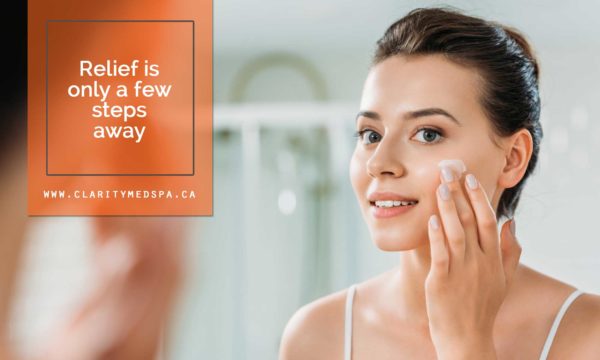How to Treat Adult Acne
Having to deal with adult acne can be frustrating. Fortunately, advances in skin care approaches, products, and technology have made treatment of adult acne more effective.
According to the Canadian Dermatology Association (CDA), about 20% of Canadians suffer from acne. Since the majority of that number (about ⅔) are between the ages of 12-19 years, acne problems are primarily associated with teenagers. However, for many adults, issues with acne persist (or become worse). For some, the flare ups begin in their 20s or 30s — even if they managed to avoid breakouts as teens. Up to 30% of sufferers are adults between the ages of 20 and 40.

Adult Acne vs. Teen Acne
Though acne can appear all over the face and comes in varying degrees of severity , teenagers commonly experience breakouts of whiteheads, blackheads, and cysts on the cheeks and forehead. Adult breakouts, on the other hand, tend to be cystic in nature. Blemishes are generally found on the lower parts of the face (particularly on the chin, jawline, and neck).

Causes of Adult Acne
Approximately 75% of adult acne sufferers are women. The causes include:
Hormonal Fluctuations
The endocrine system secretes hormones that regulate bodily functions, including the production of oil and the body’s immune responses. Fluctuations in hormones can result in the overproduction of sebum. They may also reduce the body’s ability to fight against bacteria, making it a common culprit for acne breakouts. Known as “cyclical acne,” these flare ups can occur prior to a menstrual period, during pregnancy, or at the onset of menopause.

Stress
Stress is a common contributor to hormonal fluctuations and imbalance. When experiencing high levels of stress, the adrenal gland produces cortisol, a hormone intended to help the body manage stress. Unfortunately, this hormone release also leads to increased levels of androgens (hormones that stimulate oil glands), triggering acne breakouts.
Genetics
Studies suggest that family history and genetic makeup may also be responsible for an individual’s predisposition to acne breakouts. Those of us who have close relatives (e.g. parent/s or sibling/s) suffering from acne are more likely to develop acne.
Pollution
Air pollution is especially problematic for those who live in urban areas. Dust, dirt, and debris can collect on skin and clog pores. Another factor that can contribute to redness and irritation are free radicals. They compromise healthy cells, making the skin more susceptible to inflammation.
Cosmetics and Skin Care Products
Certain makeup and skin care products contain ingredients that are comedogenic (i.e. acne-inducing). There is, however, no “one-size-fits-all” recommendation when it comes to the ingredients to use or avoid. Various elements affect individuals differently. Consult with your dermatologist or skin care expert to determine which cleaning regimen and makeup is best for your skin. Discontinue use of any product that causes a skin reaction or irritation.
Overwashing
Proper cleansing is recommended to prevent harm to the face and skin. Washing should be done gently and only twice a day. Scrubbing too intensely and for too long (particularly with coarse cleansers) can cause micro-tears in the skin, leaving pores vulnerable to pimple-causing bacteria.
Diet
Although chocolate and fatty foods are often suspects, no major scientific studies or research show a connection. However, certain food ingredients (like dairy or nuts) may trigger allergic reactions in some individuals.
Consumption of high-glycemic (i.e. sugary) food, on the other hand, can raise insulin levels. Spikes in insulin increase oil production, blocking pores and aggravating inflammation. Cow’s milk can also be linked to acne. Contrary to popular belief, milk itself does not cause a breakout; the hormones in the beverage can.

Medication
Acne is rarely caused by prescription or over-the-counter drugs. Nonetheless, certain medications contain ingredients that can induce acne or acne-like bumps. These medications include:
- Corticosteroids (for inflammation and allergic reactions)
- Lithium (treats bipolar disorder)
- DHEA (dehydroepiandrosterone) supplements (used for anti-aging)
- Barbiturates (ingredients in depressants and sedatives)
- Anticonvulsants (prescribed for patients with seizure disorders)
- Bromides and Iodides (found in cough syrup and sedatives)
- Immunosuppressants (ingested to prevent organ rejection after a transplant)
- Testosterone (often used with hormone replacement therapy)

Treating Adult Acne
Reducing or ridding yourself of acne is possible. Consider these options:
Eliminate Triggers
Avoid high-glycemic food and eat more complex carbohydrates (like whole grains and vegetables) or low-glycemic food. Reduce your intake of milk and cheese — or switch to non-dairy alternatives — if you experience hormone fluctuations. If your body reacts to certain types of food (like chocolate), remove them from your diet.
Change Cosmetic Products
Discovering which makeup or skin care product may be causing your acne is a slow process. The best plan is to use organic or natural cleansers that are devoid of harmful chemicals.
Use products that are suitable for your skin type. When making a purchase, look for the following labels:
- Water-based
- Oil-free
- Non-comedogenic
- Non-acnegenic
- Free of Oxybenzone, other suspected photo-allergens and endocrine receptors
- Free of “soluble” filters
- Paraben-free
- No dyes or mineral oil
- Fragrance-free

Eve Taylor® Essential Oils & Aromatherapy
Use Physical Exfoliants
Exfoliation removes dead skin cells that can clog pores and trap sebum. Physical exfoliants (e.g. scrubs) should be used sparingly, no more than 1-2 times per week (and only once a week for those with sensitive skin). Microdermabrasion can be performed only every 2-4 weeks.
Exfoliants are recommended for mild cases of acne. Scrubs and products with microbeads can aggravate severely inflamed skin. Consult with a doctor, nurse, or skin care expert to learn if this treatment is suitable for you.
Use Safe, Anti-Acne Products
Talk to your skin care professional about these applications:
Retinol – A form of vitamin A that effectively treats acne, boosts cell turnover, reduces dark spots, and helps manage hormonal changes.
Glycolic acid – This ingredient stimulates the skin’s natural ability to exfoliate and traps moisture while minimizing the appearance of dark spots.
Salicylic acid – An ingredient in exfoliating cleansers; it stimulates the removal of dead skin cells, unclogging pores, and preventing inflammation.
Benzoyl peroxide – This antibacterial also exfoliates skin. It is to be used sparingly since it can cause dryness and irritation.
For the best results, consult with a medical skin specialist before you purchase cleaning products.
Manage Stress
If your acne flare ups are stress-related, you can begin to manage stress through activities including yoga, meditation, and/or exercise.
Seek the help of professionals to help you find the most suitable solution for adult acne. Trying to use home remedies or treat a serious skin condition may only worsen the issue.


Clarity Medspa & Laser has over 23 years of experience in providing solutions to a variety of skin problems. We offer treatments to help manage or eliminate acne problems in Toronto. Call today or send us an email for a free consultation: (416) 960-2222.


 Linkedin
Linkedin Facebook
Facebook  Instagram
Instagram  Twitter
Twitter  Youtube
Youtube